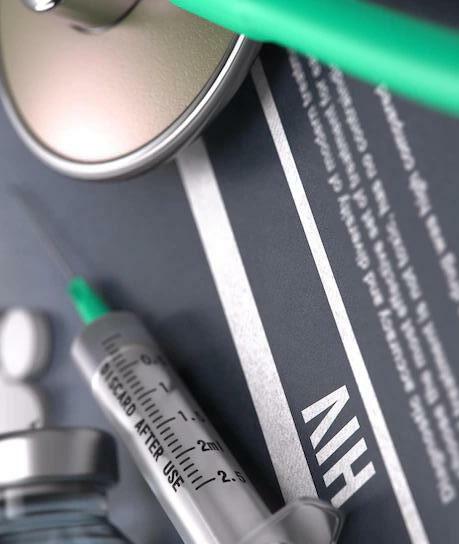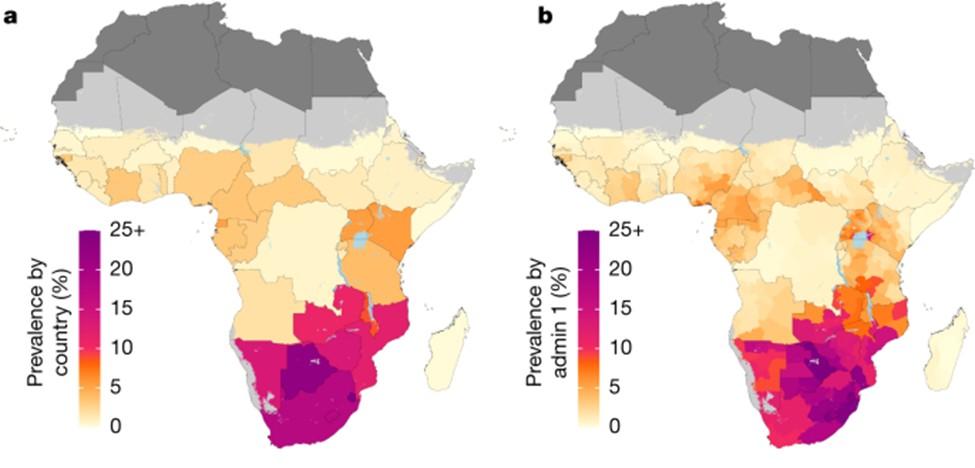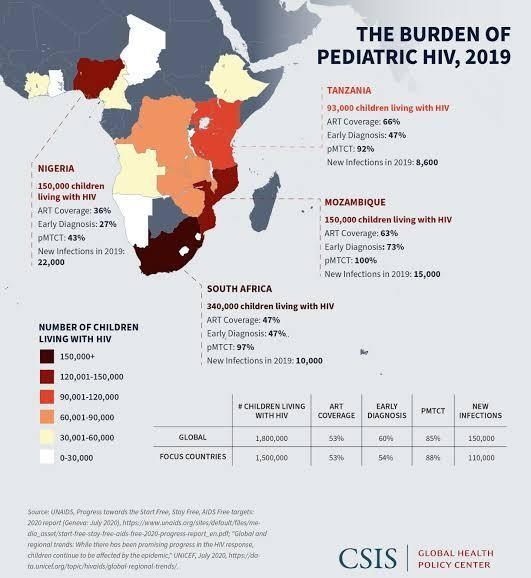Antiretroviral Therapy
Nonadherence to ART Greater in SSA?
For HIV drugs to work optimally, high levels of adherence to ART, i.e. more than 95%, are essential⁹ However, research indicates that incidences of nonadherence are quite remarkable in Africa. A Ugandan study found that only 90% of adolescents had greater than 95% adherence¹⁰ A similar study conducted in Nigeria reports adherence rates of 92.6% among adults living with HIV who are on ART¹¹. A multi centre study comparing adherence in SSA and Asia reports nonadherence rates of 6.4% in SSA and 4.8% in Asia, within the �rst 24 months of ART initiation¹².
Patient reported barriers to adherence include stigma, side e�ects of drugs, forgetfulness, lack of assistance, and travelling¹³. The impact of religious beliefs on adherence remains largely underexplored in the literature¹⁴
Facilitators of adherence include social support, reminders, feeling better after taking HIV medications, disclosing one's sero-status, and having a good relationship with the provider¹⁵. Stigma reflects di�cult relations between people living with HIV and their HIV negative peers and adults. Most interventions target only those with HIV, suggesting a policy shift towards the wider community could be bene�cial¹³
Resilience in ARV Distribution During the COVID-19 Era
A study done in Kenya's Kibera slum noted a 56% reduction in the uptake of HIV services. 11% of the individuals did not access health facilities for fear of contracting COVID-19¹⁸. Lockdowns enforced in several countries in the world left PLWHA unable to access their treatment. Moreover, those allowed visits to the clinic to collect their medication were put at risk of contracting COVID 19.
Several strategies were thus put in place to combat the risk to PLWHA brought about by the COVID-19 pandemic. For instance, PEPFAR worked with various MoH in the 21 PEPFAR-supported countries to scale up MMD¹⁶. In countries like Zambia, under the guidance of MoH, there was implementation of an extension of antiretroviral therapy re�ll duration to 6 MMD, as well as mobilization of early ART re�lls by those in HIV care¹⁹
Moreover, governments in various countries such as Uganda, after easing restrictions due to COVID 19, ensured continued HIV care and services by implementing services to return viral load testing to normal¹⁷. Restoration of viral load testing in a bid to note clinical deterioration was combined with ART distribution, where the country relied on volunteers in the network of PLWHA to directly deliver ARVs to communities. These measures have been a great help in managing the treatment of PLWHA post-COVID.
HIV Drug Resistance in Most LMICs is Above WHO's 10% Threshold
Over the past ten years, ART has expanded at an unparalleled rate; by the end of June 2020, 26 million people were getting ART globally. However, ART e�ectiveness may be compromised by the emergence of HIV drug resistance²⁰. Drug resistance may be primary or acquired: it may have been developed after exposure to ART medications (acquired), or it may have been transmitted during infection (primary)²¹.
The 2019 WHO global report on HIV drug resistance revealed a prevalence of 10% in pre treatment HIV medication resistance to NNRTIS among people starting or restarting �rst line ART in most LMICs²². However, in a cross-sectional study done on ART resistance among adults initiating ART in Uganda in 2016, the overall HIVDR and NNRTI prevalence rates were 18% and 14%, respectively This was above the WHO threshold of 10%²³ In most SSA countries, more than 50% of treatment-naive infants newly diagnosed with HIV carry a virus that is resistant to NNRTIs and more than 10% of them are resistant to NRTIs²².
ARVs risk becoming ine�ective if HIV drug resistance is not addressed²². The rising prevalence of HIV drug resistance to commonly prescribed ART drugs threatens the HIV response and could lead to an increase in HIV incidence, mortality, and treatment costs²⁴.
HIV Testing
HIV Self Testing in SSA: Acceptability, Implications and Gaps
Several HIV testing models have been rolled out in SSA to improve access to HIV testing services. Among these models is HIV self testing, which involves collecting one's own specimen (blood or oral fluid) and then using a rapid HIV test kit to test one's HIV status. Oral HIV self-testing is a high-impact innovative means of increasing HIV case identi�cation²⁵. It is a method that provides con�dential testing environments²⁶. Therefore, barriers to HIV testing such as discrimination, stigma, and lack of privacy can be overcome.
A scoping study targeting SSA revealed a variable acceptability rate of 22.3% to 94% of HIV self-testing, with men having a higher acceptability rate compared to women²⁶. The uptake of these services is poor and research around HIV self-testing in SSA is still in its infancy stages. Strategies such as the HIV self testing AfRica (STAR) initiative (2015) have been helpful in scaling up HIV self testing services in Africa²⁷. It includes critical investments in research, Implementation, market forecasting, and engagement with stakeholders.
It is important to note that HIV self-testing results are usually reliable for long-standing infections and may not detect recent infections. Therefore, just like with any other screening test a positive result must be con�rmed with two follow-up tests. There are situations in which, self tests may not be accurate, and these include recent HIV infection, people diagnosed with HIV who are on ART, people taking PrEP or PEP, and when the test instructions have not been correctly followed.
Factors that facilitate HIV self testing uptake include privacy, self empowerment, convenience, and ease of use²⁸. The barriers include the high cost of kits, low literacy levels, and fear and anxiety of positive results²⁸ Users also demonstrated a preference for oral fluid testing due to its less invasive nature compared to the whole blood-based method³⁰. HIV self-testing could revolutionize testing in Africa and in order to ensure its uptake, innovative and user-friendly approaches
be adopted
should
²⁹ .
HIV Testing in Gestational Women Seems Capricious

38 million people are HIV/AIDS positive globally4. Of these, 1.8 million are children under 15, and 17 million are women³⁰ 90% of infant HIV infections are via MTCT³⁰,³¹ The predominant risk factors for MTCT are pregnancy, delivery, and breastfeeding, but infection rates vary³². Research shows that more than half of MTCT occurs in the latter weeks of pregnancy, or during labor and delivery³³. PMTCT interventions reduce MTCT rates³⁴. These interventions include HIV testing, enrolling in treatment early in pregnancy, managing births, advising on breastfeeding, and caring for children
Studies show that pregnant women's knowledge of MTCT, age, stigma, and present living arrangements are predictors of their intention to get tested; younger women are more likely to be tested³⁵ ³⁷ . This may be due to the fact that younger women are more likely to have access to information and expertise about MTCT, have a better understanding of the bene�ts of HIV testing, and are more capable of making sound choices about whether or not to go for HIV testing³⁸. Women who live with their extended family have a higher intention of being tested for HIV than women who live in nuclear families. It is possible that this is because of the impact of grandmothers, aunts, and other female relatives on their female o�spring. Many pregnant women, according to some studies, refuse to be tested for HIV because of the stigma associated with the disease Many women feared being abandoned by their boyfriends if HIV testing revealed a positive result³⁵.
References
GBD 2017 Disease and Injury Incidence and Prevalence Collaborators (2018). Global, regional, and national incidence, prevalence, and years lived with disability for 354 diseases and injuries for 195 countries and territories, 1990 2017: a systematic analysis for the Global Burden of Disease Study 2017 Lancet (London, England), 392(10159), 1789 1858 https://doi.org/10 1016/S0140 6736(18)32279 7
GBD 2017 Causes of Death Collaborators (2018). Global, regional, and national age-sex-speci�c mortality for 282 causes of death in 195 countries and territories, 1980 2017: a systematic analysis for the Global Burden of Disease Study 2017 Lancet (London, England), 392(10159), 1736 1788 https://doi.org/10 1016/S0140 6736(18)32203-7
WHO Africa Health Topics HIV/AIDS https://www.afro.who.int/health-topics/hivaids
UNAIDS Global AIDS Update 2022.
Teasdale, C. A., Zimba, R., Abrams, E. J., Sachathep, K., Ndagije, F., Nuwagaba-Biribonwoha, H., Musuka, G., Mugurungi, O., Maile, L., Mahy, M., & Low, A. (2022). Estimates of the prevalence of undiagnosed HIV among children living with HIV in Eswatini, Lesotho, Malawi, Namibia, Tanzania, Zambia, and Zimbabwe from 2015 to 2017: an analysis of data from the cross-sectional Population-basedHIV Impact Assessment surveys. The lancet. HIV, 9(2), e91 e101 https://doi.org/10 1016/S2352 3018(21)00291 5.
Masoza, T. S., Rwezaula, R., Msanga, D. R., Chami, N., Kabirigi, J., Ambrose, E., Muro, R., Mongella, S., Hokororo, A., Kwiyolecha, E., & Peck, R. (2022). Prevalence and outcome of HIV infected children admitted in a tertiary hospital in Northern Tanzania. BMC pediatrics, 22(1), 101 https://doi.org/10 1186/s12887 022 03105-8
Slogrove, A. L., Powis, K. M., Johnson, L. F., Stover, J., & Mahy, M. (2020). Estimates of the global population of children who are HIV exposed and uninfected, 2000 18: a modelling study The Lancet. Global health, 8(1), e67 e75. https://doi.org/10 1016/S2214 109X(19)30448-6
Ogunbosi, B. O., Oladokun, R. E., Brown, B. J., & Osinusi, K. I (2011) Prevalence and clinical pattern of paediatric HIV infection at the University College Hospital, Ibadan, Nigeria: a prospective cross-sectional study. Italian journal of pediatrics, 37, 29 https://doi.org/10 1186/1824 7288-37 29
Haas, A. D., Msukwa, M. T., Egger, M., Tenthani, L., Tweya, H., Jahn, A., Gadabu, O. J., Tal, K., Salazar Vizcaya, L., Estill, J., Spoerri, A., Phiri, N., Chimbwandira, F., van Oosterhout, J. J., & Keiser, O. (2016). Adherence to Antiretroviral Therapy During and After Pregnancy: Cohort Study on Women Receiving Care in Malawi's Option B+ Program. Clinical infectious diseases : an o�cial publication of the Infectious Diseases Society of America, 63(9), 1227 1235. https://doi.org/10 1093/cid/ciw500
Nabukeera-Barungi, N., Elyanu, P., Asire, B., Katureebe, C., Lukabwe, I., Namusoke, E., Musinguzi, J., Atuyambe, L., & Tumwesigye, N. (2015). Adherence to antiretroviral therapy and retention in care for adolescents living with HIV from 10 districts in Uganda. BMC infectious diseases, 15, 520. https://doi.org/10 1186/s12879 015 1265 5.
Bijker, R., Jiamsakul, A., Kityo, C., Kiertiburanakul, S., Siwale, M., Phanuphak, P., Akanmu, S., Chaiwarith, R., Wit, F. W., Sim, B. L., Boender, T. S., Ditangco, R., Rinke De Wit, T. F., Sohn, A. H., & Hamers, R. L. (2017). Adherence to antiretroviral therapy for HIV in sub-Saharan Africa and Asia: a comparative analysis of two regional cohorts. Journal of the International AIDS Society, 20(1), 21218 https://doi.org/10 7448/IAS.20 1 21218
Anyaike, C., Atoyebi, O A., Musa, O. I., Bolarinwa, O. A., Durowade, K A., Ogundiran, A., & Babatunde, O. A. (2019) Adherence to combined Antiretroviral therapy (cART) among people living with HIV/AIDS in a Tertiary Hospital in Ilorin, Nigeria. The Pan African medical journal, 32, 10 https://doi.org/10 11604/pamj.2019.32.10 7508
Ammon, N., Mason, S., & Corkery, J. M. (2018). Factors impacting antiretroviral therapy adherence among human immunode�ciency virus-positive adolescents in Sub-Saharan Africa: a systematic review. Public health, 157, 20 31 https://doi.org/10 1016/j.puhe 201712.010
Azia, I., Mukumbang, F. C., Shernaaz, C., & Nyembezi, A. (2022). Role of religious beliefs on antiretroviral treatment adherence among Pentecostal Christians in sub-Saharan Africa: a scoping review protocol. BMJ open, 12(4), e052750 https://doi.org/10 1136/bmjopen-2021 052750
Croome, N., Ahluwalia, M., Hughes, L. D., & Abas, M. (2017). Patient-reported barriers and facilitators to antiretroviral adherence in sub-Saharan Africa AIDS (London, England), 31(7), 995 1007 https://doi.org/10 1097/QAD 0000000000001416
Bailey, L. E., Siberry, G. K., Agaba, P., Douglas, M., Clinkscales, J. R., & Godfrey, C (2021). The impact of COVID 19 on multi month dispensing (MMD) policies for antiretroviral therapy (ART) and MMD uptake in 21 PEPFAR‐supported countries: A multi country analysis. Journal of the International AIDS Society, 24(S6) https://doi.org/10 1002/jia2.25794
Lecher, S. L., Naluguza, M., Mwangi, C., N'tale, J., Edgil, D., Alemnji, G., & Alexander, H. (2021). Notes from the Field: Impact of the COVID 19 Response on Scale Up of HIV Viral Load Testing—PEPFAR-Supported Countries, January–June 2020. MMWR. Morbidity and Mortality Weekly Report, 70(21), 794 795. https://doi.org/10 15585/mmwr.mm7021a3
Muhula, S., Opanga, Y., Oramisi, V., Ngugi, C., Ngunu, C., Carter, J., Marita, E., Osur, J., & Memiah, P. (2021) Impact of the First Wave of the COVID 19 Pandemic on HIV/AIDS Programming in Kenya: Evidence from Kibera Informal Settlement and COVID 19 Hotspot Counties. International Journal of Environmental Research and Public Health, 18(11), 6009 https://doi.org/10.3390/ijerph18116009
Pry, J. M., Sikombe, K., Mody, A., Iyer, S., Mutale, J., Vlahakis, N., Savory, T., Wa Mwanza, M., Mweebo, K., Mwila, A., Mwale, C., Mukumbwa-Mwenechanya, M., Kerkho�, A. D., Sikazwe, I., Bolton Moore, C., Mwamba, D., Geng, E. H., & Herce, M. E (2022). Mitigating the e�ects of COVID 19 on HIV treatment and care in Lusaka, Zambia: A before–after cohort study using mixed e�ects regression. BMJ Global Health, 7(1), e007312. https://doi.org/10.1136/bmjgh-2021 007312.
20. HIV drug resistance strategy, 2021 update. Geneva: World Health Organization; 2021. Licence: CC BY NC-SA 3.0 IGO.
Guo, C., Wu, Y., Zhang, Y., Liu, X., Li, A., Gao, M., Zhang, T., Wu, H., Chen, G., & Huang, X. (2021)
Transmitted Drug Resistance in Antiretroviral Therapy Naive Persons With Acute/ Early/Primary HIV Infection: A Systematic Review and Meta-Analysis. Frontiers in pharmacology, 12, 718763 https://doi.org/10.3389/fphar 2021 718763
World Health Organization. HIV drug resistance report 2019. Geneva: World Health Organization; 2019 Contract No.: WHO/CDS/HIV/19 21
Watera, C., Ssemwanga, D., Namayanja, G., Asio, J., Lutalo, T., Namale, A., Sanyu, G., Ssewanyana, I., Gonzalez-Salazar, J. F., Nazziwa, J., Nanyonjo, M., Raizes, E., Kabuga, U., Mwangi, C., Kirungi, W., Musinguzi, J., Mugagga, K., Mbidde, E. K., & Kaleebu, P. (2021). HIV drug resistance among adultsinitiating antiretroviral therapy in Uganda. The Journal of antimicrobial chemotherapy, 76(9), 2407 2414 https://doi.org/10 1093/jac/dkab159
World Health Organization. Global action plan on HIV drug resistance 2017 2021
Estem, K. S., Catania, J., & Klausner, J. D. (2016) HIV Self Testing: a Review of Current Implementation and Fidelity. Current HIV/AIDS reports, 13(2), 107 115. https://doi.org/10 1007/s11904 016 0307 y
Harichund, C., & Moshabela, M. (2018). Acceptability of HIV Self Testing in Sub-Saharan Africa: Scoping Study. AIDS and behavior, 22(2), 560 568 https://doi.org/10 1007/s10461 017 1848-9
Ingold, H., Mwerinde, O., Ross, A. L., Leach, R., Corbett, E. L., Hatzold, K., Johnson, C. C., Ncube, G., Nyirenda, R., & Baggaley, R. C. (2019). The Self Testing AfRica (STAR) Initiative: accelerating global access and scale-up of HIV self testing. Journal of the International AIDS Society, 22 Suppl 1(Suppl Suppl1), e25249 https://doi.org/10 1002/jia2.25249
Njau, B., Covin, C., Lisasi, E., Damian, D., Mushi, D., Boulle, A., & Mathews, C. (2019)
of
T., Knight, L., Taegtmeyer,
on
health, 19(1), 1289.
Tulloch,
and deterring uptake
Davids, A., Lim, J., Peck, R., &
in South
one,
A systematic review
qualitative evidence
factors enabling
of HIV self testing in Africa. BMC public
https://doi.org/10.1186/s12889 019 7685 1. Makusha,
M.,
O.,
van Rooyen, H. (2015). HIV self testing could "revolutionize testing
Africa, but it has got to be done properly": perceptions of key stakeholders. PloS
10(3), e0122783 https://doi.org/10 1371/journal.pone 0122783 UNAIDS.AIDS by the Numbers 2016; UNAIDS: Geneva, Switzerland, 2016 1 2 3 4 5 6 7 8 9 11 12 13 14 15 16 17 18 19 19 21 22 23 24 25 26 27 28 29 30 10
Reece, M., Hollub, A., Nangami, M., & Lane, K. (2010) Assessing male spousal engagement with prevention of mother to child transmission (pMTCT) programs in western Kenya. AIDS care, 22(6), 743–750 h ttps://doi.org/10 1080/09540120903431330
Rouzioux, C., Costagliola, D., Burgard, M., Blanche, S., Mayaux, M. J., Griscelli, C., & Valleron, A. J. (1995). Estimated timing of mother to child human immunode�ciency virus type 1 (HIV 1) transmission by use of a Markov model. The HIV Infection in Newborns French Collaborative Study Group. American journal of epidemiology, 142(12), 1330 1337 https://doi.org/10 1093/oxfordjournals.aje.a117601
Guay, L. A., Musoke, P., Fleming, T., Bagenda, D., Allen, M., Nakabiito, C., Sherman, J., Bakaki, P., Ducar, C., Deseyve, M., Emel, L., Mirochnick, M., Fowler, M. G., Mofenson, L., Miotti, P., Drans�eld, K., Bray, D., Mmiro, F., & Jackson, J. B. (1999) Intrapartum and neonatal single dose nevirapine compared with zidovudine for prevention of mother to child transmission of HIV 1 in Kampala, Uganda: HIVNET 012 randomised trial. Lancet (London, England), 354(9181), 795–802. https://doi.org/10 1016/S0140 6736(99)80008-7
Lehman, D. A., John-Stewart, G. C., & Overbaugh, J (2009). Antiretroviral strategies to prevent mother to child transmission of HIV: striking a balance between e�cacy, feasibility, and resistance. PLoS medicine, 6(10), e1000169 https://doi.org/10 1371/journal.pmed.1000169
Anand, A., Shiraishi, R. W., Sheikh, A. A., Marum, L. H., Bolu, O., Mutsotso, W., Sabin, K., Ayisi, R., & Diaz, T. (2009). Site factors may be more important than participant factors in explaining HIV test acceptance in the prevention of mother to child HIV transmission programme in Kenya, 2005. Tropical medicine & international health : TM & IH,, 14(10), 1215 1219 https://doi.org/10 1111/j.1365 3156 2009 02367.x.
Elsiddig Elsheikh, I., Crutzen, R., Adam, I., Ibrahim Abdelraheem, S., & Van den Borne, H. W. (2022). Determinants of HIV Testing during Pregnancy among Pregnant Sudanese Women: A Cross-Sectional Study. Behavioral sciences (Basel, Switzerland), 12(5), 150 https://doi.org/10.3390/bs12050150
Kilewo, C., Massawe, A., Lyamuya, E., Semali, I., Kalokola, F., Urassa, E., Giattas, M., Temu, F., Karlsson, K., Mhalu, F., & Biberfeld, G. (2001) HIV counseling and testing of pregnant women in sub-Saharan Africa: experiences from a study on prevention of mother to child HIV 1 transmission in Dar es Salaam, Tanzania Journal of acquired immune de�ciency syndromes (1999), 28(5), 458–462. https://doi.org/10 1097/00042560 200112150 00009
Kalichman, S. C., & Simbayi, L. C. (2003). HIV testing attitudes, AIDS stigma, and voluntary HIV counselling and testing in a black township in Cape Town, South Africa. Sexually transmitted infections, 79(6), 442–447 https://doi.org/10 1136/sti.79 6 442.
31 32 33 34
35 36 37 38







